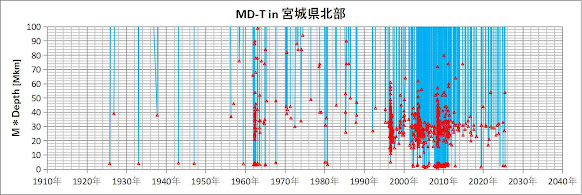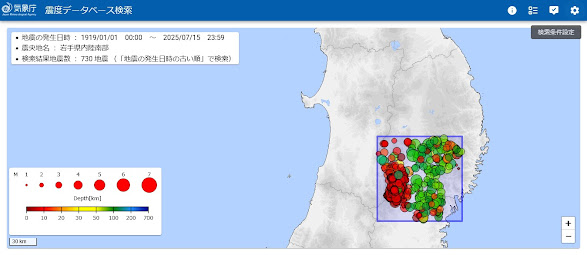Counts of occurrence per depth in 秋田県北部(Northern Akita Pref.)is shown as below graph,
The greatest magnitude is M6.8 of 1km in 1938. It was occurred on the quartet junction among 1km-30km. By the M6.8, their counts increase rapidly. 1km curve stood out as the fastest, and kept the 1st count until be overtaken by 10km curve. Only 10km curve was affected remarkably by M9.0 of Great East Japan Earthquake. The total counts of 1km-20km account for about 94% of all occurrences in this area.
- 1km (red)…The count is the 2nd. There is the rapid increase after M6.8 of 1km in 1939 after the 2nd longest silent term between 1919-1933. The next remarkable rapid increase started since 1969 until 1979. It may be due to the influence of M7.9 of 1km in Off the East Coast of Aomori Pref in 1968. The 1st longest silent term is between 1982-1997. After it, the silent terms became shorter. But, 1km curve was overtaken by 10km curve in 2012. The M6.8 in 1939 is the greatest one of all depths. The M6.8 was occurred on the quartet junction among 1km/10km/20km/30km.
- 10km (yellow)…The count is the 1st. As same as 1km, there is the rapid increase after M6.8 of 1km in 1939. Then, the silent terms became longer suddenly. The longest silent term is between 1939-1955. After it, the count increased with steep sloop. After M9.0 of Great East Japan Earthquake, the rapid increase was occurred. In result, 10km curve overtook 1km curve. The largest of 10km is M6.2 in 1998.
- 20km(orange)… The count is the 3rd. As same as 1km/10km, there is the rapid increase after M6.8 of 1km in 1939. Then, the silent terms became longer suddenly. The 2nd longest silent term is between 1939-1959. After it, 20km curve went back-and-forth of 10km until 1983. As 10km curve had the 2nd longest silent term between 1982-1993, 20km curve overtook 10km curve. But, as 10km curve became increase rapidly since 1993, 20km's count rank became down to the 3rd. The largest of 20km is M6.5 in 1939.
- others… Remaining counts except 1km-20km are only 6%.





















































